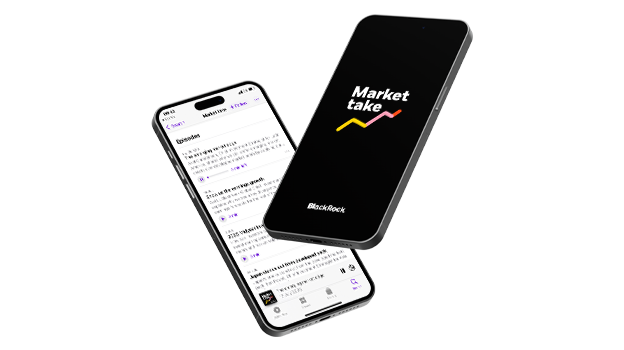Micro is macro in mega AI buildout
BlackRock Bottom Line
Wei Li
BlackRock Chief Investment Strategist
The world’s economies and markets are being transformed by mega forces, especially artificial intelligence. As we track this transformation into 2026, the three investment themes in our 2026 outlook are: one, Micro is macro; two, Leveraging up; and three, Diversification mirage.
First: Micro is macro. Companies’ capital spending ambitions tied to the AI buildout are huge - big enough to have a macroeconomic impact. The overall revenues that AI eventually generates could justify the spend at a macro level, but it’s unclear how much tech companies will capture. We think they’ll adjust plans as visibility on potential revenues and energy constraints improve.
Second: Leveraging up. AI spending comes first, benefits and revenues are likely to only come later. That creates a need for long-term financing – making greater leverage inevitable. We expect companies to keep tapping public and private credit markets, creating opportunities for investors.
Third: Diversification mirage. In markets driven by just a few forces, allocations made under the guise of diversification may now in fact be big active bets. Investors should be ready to pivot quickly. We think traditional diversifiers like long-term Treasuries will no longer be the reliable buffer they once were. We prefer exposures with their own sources of returns, such as private markets and hedge funds.
The bottom line is: we stay pro-risk and think the AI theme will remain a key driver of equity returns. We see an environment ripe for active investing.
We remain pro-risk and see the AI theme still the main driver of U.S. equities. Identifying the winners as AI revenues spread is an active investment story.
U.S. stocks rose. PCE inflation data reinforced our view that the Federal Reserve is on track to cut interest rates this week. U.S. bond yields climbed.
We eye the Fed’s economic and interest rate projections given market pricing of more rate cuts next year. We also eye delayed U.S. labor and wage data.
Mega forces are transforming the global economy and markets, especially AI. Technology is becoming capital-intensive, and the AI buildout could be unprecedented in both speed and scale. These investment ambitions are pushing limits – the title of our 2026 Global Outlook – on multiple fronts and trumping the macro. With a few mega forces driving markets, it is hard to avoid making a big call on their direction. We stay pro-risk and overweight U.S. stocks on the AI theme.
Never broken out
U.S. GDP per capita and long-term trend, 1870-2024

Source: BlackRock Investment Institute and Macrohistory Database, December 2025. Note: Historical data compiled by Òscar Jordà, Moritz Schularick, and Alan M. Taylor. 2017. Macrofinancial History and the New Business Cycle Facts. in NBER Macroeconomics Annual 2016, volume 31, edited by Martin Eichenbaum and Jonathan A. Parker. Chicago: University of Chicago Press.
The AI buildout means the micro is macro – our first theme – and its scale has sparked talk of a bubble forming. We don’t see that as a practical lens for investing. Market bubbles grow for some time and only become obvious after they burst. And framing it as a bubble focuses only on the unprecedented spend – but AI could be unprecedented both in terms of investment and potential corporate revenues. We think it is more relevant to see if and how these unprecedented dimensions can be reconciled. We find that justifying the loftiest ambitions would require a U.S. growth breakout from its long-term 2% trend that generates new pools of revenue. That’s hard to make happen. All major innovations of the past 150 years – steam, electricity and the digital revolution – were enough to keep U.S. growth at its 2% trend, not break it. See the chart. Something more is needed, and AI could deliver it.
AI makes such an unprecedented breakout conceivable because it has the potential to innovate the process of innovation itself, generating and improving new concepts on its own. This self-reinforcing loop is key to achieving the growth breakout and expanding the overall revenues. But we don’t know if this will happen – and even if all these revenues are generated, it’s unclear who will capture them. Entirely new AI-created revenue streams could develop and spread across sectors and the economy. It’s also unclear who the winners will be within tech: the capex may pay off overall, but not for individual companies. That’s why we think the AI theme will become an active investing story. The current AI builders have room to grow their share of the revenue as they eat into parts of the tech ecosystem, like software. But we should not expect these companies to be on autopilot. Their investment ambitions are not yet reality, and they could adjust as more clarity on revenues emerges and stark physical constraints bite. Yet we see opportunities where these constraints are most acute, especially energy.
Never broken out
The front-loaded investment in the AI buildout and back-loaded revenues creates a financing hump – and that makes greater leverage inevitable, as seen from big tech corporate bond sales. That’s why our second Outlook theme is leveraging up. The good news: the starting point for private sector leverage is healthy, particularly listed tech. But along with highly indebted governments, this leverage creates a financial system vulnerable to shocks – including bond yield spikes tied to policy tensions between inflation and debt sustainability. We think infrastructure and both public and private markets will support this financing. We favor short- and medium-term U.S. Treasuries and renew our underweight to long-term bonds.
A diversification mirage, our third theme, has emerged with a few mega forces driving markets. Attempts to diversify away from the U.S. or AI amount to larger active calls than before. And traditional diversifiers like long-term bonds do not offer the portfolio ballast they once did. We think investors should focus less on spreading risk and more on owning it deliberately. Strategies like private markets and hedge funds pair diversification with strong return potential, in our view.
Our bottom line
AI’s self-reinforcing innovation loop could break the U.S. out of its 2% growth trend and reconcile big AI buildout spend with potential revenues. We stay overweight U.S. stocks and favor a more active approach as AI gains spread.
Market backdrop
U.S. stocks advanced after a tame inflation report buoyed expectations for the Fed to cut policy rates again this week. The S&P 500’s mild rise brought its 2025 gain to 17%. Delayed U.S. PCE inflation data for September was in line with expectations, reinforcing our view that the Fed is on track to cut. Bitcoin came under renewed pressure and was down about 30% from its record high. U.S. Treasury yields climbed back near the top of their rough 4.00-4.20% range.
All eyes are on the Federal Reserve, with markets widely expecting a third straight rate cut as the labor market cools – and we agree with those expectations. Also key is what the Fed signals about policy rates next year given market pricing of at least two more cuts and officials becoming more divided on how much more to cut rates. China’s CPI and PPI reports should shed light on whether Beijing’s efforts to combat deflation are taking effect.
Week ahead

Past performance is not a reliable indicator of current or future results. Indexes are unmanaged and do not account for fees. It is not possible to invest directly in an index. Sources: BlackRock Investment Institute, with data from LSEG Datastream as of December 4, 2025. Notes: The two ends of the bars show the lowest and highest returns at any point year to date, and the dots represent current year-to-date returns. Emerging market (EM), high yield and global corporate investment grade (IG) returns are denominated in U.S. dollars, and the rest in local currencies. Indexes or prices used are: spot Brent crude, ICE U.S. Dollar Index (DXY), spot gold, spot bitcoin, MSCI Emerging Markets Index, MSCI Europe Index, LSEG Datastream 10-year benchmark government bond index (U.S., Germany and Italy), Bloomberg Global High Yield Index, J.P. Morgan EMBI Index, Bloomberg Global Corporate Index and MSCI USA Index.
China trade
U.S. job openings
Fed policy decision; China CPI;
Q3 U.S. Employment Cost Index
UK GDP
Read our past weekly market commentaries here.
Big calls
Our highest conviction views on six- to 12-month (tactical) and over five-year (strategic) horizons, December 2025
| Reasons | ||
|---|---|---|
| Tactical | ||
| Still favor AI | We see the AI theme supported by strong earnings, resilient profit margins and healthy balance sheets at large listed tech companies. Continued Fed easing into 2026 and reduced policy uncertainty underpin our overweight to U.S. equities. | |
| Select international exposures | We like Japanese equities on strong nominal growth and corporate governance reforms. We stay selective in European equities, favoring financials, utilities and healthcare. In fixed income, we prefer EM due to improved economic resilience and disciplined fiscal and monetary policy. | |
| Evolving diversifiers | We suggest looking for a “plan B” portfolio hedge as long-dated U.S. Treasuries no longer provide portfolio ballast – and to mind potential sentiment shifts. We like gold as a tactical play with idiosyncratic drivers but don’t see it as a long-term portfolio hedge. | |
| Strategic | ||
| Portfolio construction | We favor a scenario-based approach as we learn more about AI winners and losers emerge. We lean on private markets and hedge funds for idiosyncratic return and to anchor portfolios in mega forces. | |
| Infrastructure equity and private credit | We find infrastructure equity valuations attractive and mega forces underpinning structural demand. We still like private credit but see dispersion ahead – highlighting the importance of manager selection. | |
| Beyond market-cap benchmarks | We get granular in public markets. We favor DM government bonds outside the U.S. Within equities, we favor EM over DM yet get selective in both. In EM, we like India which sits at the intersection of mega forces. In DM, we like Japan as mild inflation and corporate reforms brighten the outlook. | |
Note: Views are from a U.S. dollar perspective, December 2025. This material represents an assessment of the market environment at a specific time and is not intended to be a forecast of future events or a guarantee of future results. This information should not be relied upon by the reader as research or investment advice regarding any particular funds, strategy or security.
Tactical granular views
Six- to 12-month tactical views on selected assets vs. broad global asset classes by level of conviction, December 2025

We have lengthened our tactical investment horizon back to six to 12 months. The table below reflects this and, importantly, leaves aside the opportunity for alpha, or the potential to generate above-benchmark returns – especially at a time of heightened volatility.
| Asset | Tactical view | Commentary | ||||
|---|---|---|---|---|---|---|
| Equities | ||||||
| United States |  |
We are overweight. Strong corporate earnings, driven in part by the AI theme, are supported by a favorable macro backdrop: continued Federal Reserve easing, broad economic optimism and less policy uncertainty, particularly on the trade front. | ||||
| Europe |  |
We are neutral. We would need to see more business-friendly policy and deeper capital markets for recent outperformance to continue and to justify a broad overweight. We stay selective, favoring financials, utilities and healthcare. | ||||
| UK |  |
We are neutral. Valuations remain attractive relative to the U.S., but we see few near-term catalysts to trigger a shift. | ||||
| Japan |  |
We are overweight. Strong nominal GDP, healthy corporate capex and governance reforms – such as the decline of cross-shareholdings – all support equities. | ||||
| Emerging markets (EM) |  |
We are neutral. Economic resilience has improved, yet selectivity is key. We see opportunities across EM linked to AI and the energy transition and see the rewiring of supply chains benefiting countries like Mexico, Brazil and Vietnam. | ||||
| China |  |
We are neutral. Trade relations with the U.S. have steadied, but property stress and an aging population still constrain the macro outlook. Relatively resilient activity limits near-term policy urgency. We like sectors like AI, automation and power generation. We still favor China tech within our neutral view. | ||||
| Fixed income | ||||||
| Short U.S. Treasuries |  |
We are neutral. We see other assets offering more compelling returns as short-end yields have fallen alongside the U.S. policy rate. | ||||
| Long U.S. Treasuries |  |
We are underweight. We see high debt servicing costs and price-sensitive domestic buyers pushing up on term premium. Yet we see risks to this view: lower inflation and better tax revenues could push down yields near term. | ||||
| Global inflation-linked bonds |  |
We are neutral. We think inflation will settle above pre-pandemic levels, but markets may not price this in the near-term as growth cools. | ||||
| Euro area government bonds |  |
We are neutral. We agree with market forecasts of ECB policy and think prices reflect the risk that German fiscal issuance raises yields. We prefer government bonds outside Germany. | ||||
| UK gilts |  |
We are neutral. The recent budget aims to shore up market confidence through fiscal consolidation. But most borrowing cuts won’t go into effect for several years, leaving room for domestic pressures to hinder execution and fuel volatility. | ||||
| Japanese government bonds |  |
We are underweight. Rate hikes, higher global term premium and heavy bond issuance will likely drive yields up further. | ||||
| China government bonds |  |
We are neutral. China bonds offer stability and diversification but developed market yields are higher and investor sentiment shifting towards equities limits upside. | ||||
| U.S. agency MBS |  |
We are overweight. Agency MBS offer higher income than Treasuries with similar risk, and may offer more diversification amid fiscal and inflationary pressures. | ||||
| Short-term IG credit |  |
We are neutral. Corporate strength means spreads are low, but they could widen if issuance increases and investors rotate into U.S. Treasuries as the Fed cuts. | ||||
| Long-term IG credit |  |
We are underweight. We prefer short-term bonds less exposed to interest rate risk over long-term bonds. | ||||
| Global high yield |  |
We are neutral. High yield offers more attractive carry in an environment where growth is holding up – but we think dispersion between higher and weaker issuers will increase. | ||||
| Asia credit |  |
We are neutral. Overall yields are attractive and fundamentals are solid, but spreads are tight. | ||||
| Emerging hard currency |  |
We are overweight. A weaker U.S. dollar, lower U.S. rates and effective EM fiscal and monetary policy have improved economic resilience. We prefer high yield bonds. | ||||
| Emerging local currency |  |
We are neutral. A weaker U.S. dollar has boosted local currency EM debt, but it’s unclear if this weakening will persist. | ||||
Past performance is not a reliable indicator of current or future results. It is not possible to invest directly in an index. Note: Views are from a U.S. dollar perspective. This material represents an assessment of the market environment at a specific time and is not intended to be a forecast or guarantee of future results. This information should not be relied upon as investment advice regarding any particular fund, strategy or security.
Euro-denominated tactical granular views
Six to 12-month tactical views on selected assets vs. broad global asset classes by level of conviction, December 2025

We have lengthened our tactical investment horizon back to six to 12 months. The table below reflects this and, importantly, leaves aside the opportunity for alpha, or the potential to generate above-benchmark returns – especially at a time of heightened volatility.
| Asset | Tactical view | Commentary | ||
|---|---|---|---|---|
| Equities | ||||
| Europe ex UK |  |
We are neutral. We would need to see more business-friendly policy and deeper capital markets for recent outperformance to continue and to justify a broad overweight. We stay selective, favoring financials, utilities and healthcare. | ||
| Germany |  |
We are neutral. Increased spending on defense and infrastructure could boost the corporate sector. But valuations rose significantly in 2025 and 2026 earnings revisions for other countries are outpacing Germany. | ||
| France |  |
We are neutral. Political uncertainty could continue to drag corporate earnings behind peer markets. Yet some major French firms are shielded from domestic weakness, as foreign activity accounts for most of their revenues and operations. | ||
| Italy |  |
We are neutral. Valuations are supportive relative to peers. Yet we think the growth and earnings outperformance that characterized 2022-2023 is unlikely to persist as fiscal consolidation continues and the impact of prior stimulus peters out. | ||
| Spain |  |
We are overweight. Valuations and earnings growth are supportive relative to peers. Financials, utilities and infrastructure stocks stand to gain from a strong economic backdrop and advancements in AI. High exposure to fast-growing areas like emerging markets is also supportive. | ||
| Netherlands |  |
We are neutral. Technology and semiconductors feature heavily in the Dutch stock market, but that’s offset by other sectors seeing less favorable valuations and a weaker earnings outlook than European peers. | ||
| Switzerland |  |
We are neutral. Valuations have improved, but the earnings outlook is weaker than other European markets. If global risk appetite stays strong, the index’s tilt to stable, less volatile sectors may weigh on performance. | ||
| UK |  |
We are neutral. Valuations remain attractive relative to the U.S., but we see few near-term catalysts to trigger a shift. | ||
| Fixed income | ||||
| Euro area government bonds |  |
We are neutral. We agree with market forecasts of ECB policy and think current prices largely reflect increased German bond issuance to finance its fiscal stimulus package. We prefer government bonds outside Germany. | ||
| German bunds |  |
We are neutral. Markets have largely priced in fiscal stimulus and bond issuance, and expectations for policy rates align with our view. | ||
| French OATs |  |
We are neutral. Political uncertainty, high budget deficits and slow structural reforms could stoke volatility, but current spreads incorporate these risks and we don’t expect a worsening from here. | ||
| Italian BTPs |  |
We are neutral. Demand from Italian households is strong at current yield levels. Spreads tightened in line with its sovereign credit upgrade, but a persistently high debt-to-GDP levels means they likely won’t tighten further. | ||
| UK gilts |  |
We are neutral. The recent budget aims to shore up market confidence through fiscal consolidation. But deferred borrowing cuts could bring back gilt market volatility. | ||
| Swiss government bonds |  |
We are neutral. We don’t think the Swiss National Bank will slash policy rates to below zero, as markets expect. | ||
| European inflation-protected securities |  |
We are neutral. Our medium-term inflation expectations align with those implied in current market pricing. | ||
| European investment grade |  |
We are neutral. We favor short- to medium-term debt and Europe over the U.S. An intense re-leveraging cycle to support the AI buildout could put upward pressure on U.S. spreads, making Europe relatively more attractive. | ||
| European high yield |  |
We are overweight. Spreads hover near historic lows, but credit losses have been limited in this cycle and better economic growth in 2026 could reduce them further. | ||
Past performance is not a reliable indicator of current or future results. It is not possible to invest directly in an index. Note: Views are from a euro perspective, December 2025. This material represents an assessment of the market environment at a specific time and is not intended to be a forecast or guarantee of future results. This information should not be relied upon as investment advice regarding any particular fund, strategy or security.
On the go?





